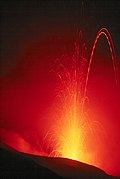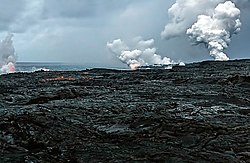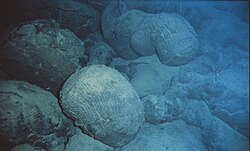Lava

Lava is magma, hot molten rock that flows through holes in the Earth's crust and onto the surface. Like magma, lava can be either viscous (~thick) or fluid (~thin).[1] Blocky lava is so thick and slow that it barely moves along the ground. Other types of lava, like pahoehoe, aa, and pillow lava, are thinner and flow faster.[1] Lava sometimes sets things on fire. Sometimes it even destroys towns.
Types of lava
Blocky lava
Blocky lava is cool, stiff lava that cannot travel far from where it was erupted. Blocky lava usually oozes out from a volcano only after an explosion has let out lots of the gas pressure from the place where there is magma. Blocky lava makes jumbled piles of sharp chunks.
Pahoehoe
Pronounced pah HOY HOY,[1] pahoehoe gets its name from the Hawaiian word for "ropy" because its surface looks like coils of rope. Pahoehoe lava flows slowly, like wax dripping down from a candle, making a glassy surface with round wrinkles.[1]
Aa
Aa is a Hawaiian word that is pronounced AH-AH. This lava that has a sharp, jagged surface.[1] This stiff lava pours out quickly and makes a crust that breaks easily. The crust is torn into sharp pieces as the hot lava underneath still moves.
Pillow lava
Pillow lava is made when lava erupts underwater. It makes round lumps that are the size and shape of pillows.[1] Pillow lava has a round shape because the lava cools very quickly when it touches water.[1]
They occur wherever mafic or intermediate lavas push out under water. This happens along marine hotspot volcano chains and the constructive plate boundaries of mid-ocean ridges. Pillow lavas occur in the oldest preserved volcanic sequences on earth, the Isua and Barberton greenstone belts. This shows that large bodies of water were on the Earth's surface early in the Archaean. Pillow lavas are used generally to show volcanism occurred underwater in metamorphic belts. Pillow lavas are also found where volcanoes were under ice early before an eruption.[2][3]
Lava tube
A lava tube is a natural channel formed in flowing lava. The lava continues flowing under the tube's upper surface. Later, when the lava is cooled and solid, the tube remains as a feature in the landscape.
Gallery
Stromboli eruption. The yellow/reddish things in the picture are lava.
Lava Media
Fresh lava from Fagradalsfjall volcano eruption in Iceland, 2023
Video of lava agitating and bubbling in the volcano eruption of Litli-Hrútur, 2023
Toes of a pāhoehoe advance across a road in Kalapana on the east rift zone of Kīlauea Volcano in Hawaii, United States
Columnar jointing in Giant's Causeway in Northern Ireland
Lava entering the sea to expand the big island of Hawaii, [[Hawaiʻi Volcanoes National Park]]
Lava enters the Pacific at the Big Island of Hawaii.
Block lava at Fantastic Lava Beds near Cinder Cone in Lassen Volcanic National Park
Pillow lava on the ocean floor near Hawaii
References
- ↑ 1.0 1.1 1.2 1.3 1.4 1.5 1.6 Earth Science. Holt, Rinehart and Winston, Austin, Texas. 2001. ISBN 0-03-055667-8.
- ↑ "Introduction to geology and geodynamics of Iceland, R.G. Trønnes, Nordic volcanological Institute, University of Iceland" (PDF). Archived from the original (PDF) on 2010-08-14. Retrieved 2012-07-31.
- ↑ Scientists Study 'Glaciovolcanoes,' mountains of fire and ice, in Iceland, British Columbia, US ScienceDaily, Apr. 23, 2010
Other websites
| Wikimedia Commons has media related to Lua error in Module:Commons_link at line 62: attempt to index field 'wikibase' (a nil value).. |











